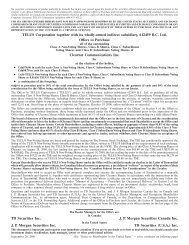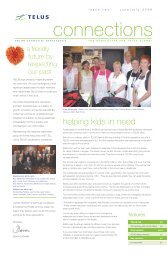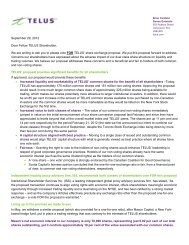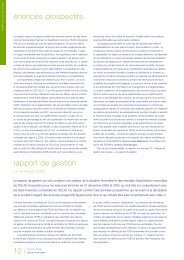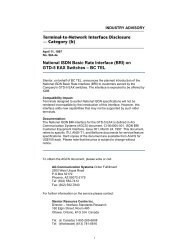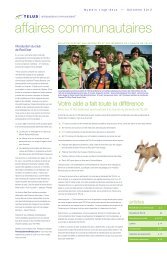TELUS Residential Multi-Dwelling Unit (MDU)“Optik ... - About TELUS
TELUS Residential Multi-Dwelling Unit (MDU)“Optik ... - About TELUS
TELUS Residential Multi-Dwelling Unit (MDU)“Optik ... - About TELUS
Create successful ePaper yourself
Turn your PDF publications into a flip-book with our unique Google optimized e-Paper software.
Page 1 of 25<br />
Building Industry<br />
Consulting Services<br />
(BICS)<br />
<strong>TELUS</strong> <strong>Residential</strong> <strong>Multi</strong>-<strong>Dwelling</strong> <strong>Unit</strong> (<strong>MDU</strong>)<br />
<strong>“Optik</strong>”<br />
Fibre-to-the Suite Servicing Guidelines<br />
for<br />
Vertical and Horizontal <strong>Multi</strong>-<strong>Dwelling</strong> <strong>Unit</strong>s
Table of Contents<br />
1. Introduction ...................................................................................................................... 3<br />
Alberta ............................................................................................................................................. 3<br />
British Columbia ............................................................................................................................. 3<br />
2. Description ...................................................................................................................... 4<br />
3. Features .......................................................................................................................... 4<br />
4. Components of an Optik <strong>MDU</strong> Distribution System .......................................................... 4<br />
4.1. Fibre Distribution Hub ........................................................................................................ 5<br />
4.2. Fibre Distribution Terminal ................................................................................................ 5<br />
4.3. Drop Cabling ........................................................................................................................ 5<br />
4.4. Optical Network Terminal .................................................................................................. 5<br />
5. <strong>TELUS</strong> Responsibilities ................................................................................................... 6<br />
6. Property Owner Responsibilities ...................................................................................... 6<br />
6.1. Cable Entrance to Buildings .............................................................................................. 6<br />
6.2. Pathways / Conduit ............................................................................................................. 6<br />
6.3. Spaces .................................................................................................................................. 6<br />
6.3.1. FDH ....................................................................................................................... 7<br />
6.3.2. FDT ....................................................................................................................... 7<br />
6.3.3. Drop ....................................................................................................................... 7<br />
6.4. Labelling .............................................................................................................................11<br />
6.5. Testing ................................................................................................................................11<br />
7. Optik vs. Copper Distribution Architecture ..................................................................... 11<br />
8. Incompatible Telephone Services & Mixed Media .......................................................... 11<br />
8.1 Business Services ............................................................................................................12<br />
8.2 Door Entry Systems..........................................................................................................12<br />
8.3 Alarms .................................................................................................................................12<br />
8.4 Video Surveillance ............................................................................................................12<br />
9. Additional Service Providers .......................................................................................... 13<br />
10. Examples of Optik Architecture ...................................................................................... 13<br />
11. More Information ........................................................................................................... 13<br />
12. Representative Cabling and Pathway (conduit) Routing ................................................ 14<br />
Page 2 of 25 2012-01-16
1. Introduction<br />
In anticipation of <strong>TELUS</strong> providing its Optik service Fibre-to-the-Suite (FTTS) for <strong>Multi</strong>ple <strong>Dwelling</strong> <strong>Unit</strong>s<br />
(<strong>MDU</strong>s) - <strong>TELUS</strong> Communications is modifying the way it will provision service to these units in the<br />
following Cities and Towns, primarily Greenfield (see note 1). In communities not listed, the current<br />
servicing model will remain unchanged.<br />
Alberta<br />
Airdrie Lethbridge<br />
Beaumont Medicine Hat<br />
Chestermere Morinville<br />
Calgary Okotoks<br />
Cochrane Red Deer<br />
Devon Sherwood Park<br />
Edmonton Spruce Grove<br />
Fort McMurray St. Albert<br />
Fort Saskatchewan Stony Plain<br />
Grande Prairie Strathmore<br />
Leduc<br />
British Columbia<br />
Abbotsford Nanaimo<br />
Belcarra New Westminster<br />
Brackindale North Vancouver<br />
Burnaby Penticton<br />
Campbell River Pitt Meadows<br />
Chilliwack Port Coquitlam<br />
Comox Port Moody<br />
Courtney Prince George<br />
Cumberland Richmond<br />
Coquitlam Squamish<br />
Delta Surrey<br />
Fort Langley Vancouver<br />
Kamloops Vernon<br />
Kelowna Victoria<br />
Langley West Vancouver<br />
Maple Ridge Whistler<br />
Mission<br />
Note 1: Contact <strong>TELUS</strong> to determine if your development qualifies for Optik fibre service.<br />
This is an exciting time for new home buyers in Western Canada as the launching of Fibre-to-the-Suite<br />
technologies is on the horizon. In all <strong>Multi</strong>ple <strong>Dwelling</strong> <strong>Unit</strong>s that are identified as Fibre fed, in primarily<br />
Greenfield areas or communities, <strong>TELUS</strong> Communications will be able to deliver Fibre Optics directly into<br />
the suite and provide Communications, Data, and High-Definition Television (HDTV) via its fibre network.<br />
Page 3 of 25 2012-01-16
We, at <strong>TELUS</strong>, appreciate your support as we embark on these exciting new times. The following<br />
information is provided as a guide to the modifications required accommodating Fibre-to-the-Suite. We<br />
anticipate that this change will be cost neutral to the developer, builder, and owner.<br />
If you have questions about implementation or you would like information on the benefits of a marketing<br />
partnership with <strong>TELUS</strong>, please find the applicable contact information provided in Section 11 of this<br />
document.<br />
2. Description<br />
This document contains important requirements for you to prepare your building(s) to receive <strong>TELUS</strong>’<br />
Optik infrastructure. Optik is <strong>TELUS</strong>’ trademark for its method of distributing traditional voice<br />
communications, high‐speed Internet connections, and digital video services (<strong>TELUS</strong> TV) over fibre optic<br />
cabling, rather than the copper and coaxial cabling that has been used for the last century. Optik uses<br />
Passive Optical Network (PON) architecture, and offers several forms of Fibre‐to‐the‐Suite (FTTS)<br />
services. Optik offers a tremendous improvement in performance and features over traditional copper<br />
cabling.<br />
3. Features<br />
Optik offers virtually unlimited bandwidth to support multiple telephone lines, ultra‐high‐speed Internet<br />
connections, and superb video delivery, including both Standard Definition (SDTV) and High‐Definition<br />
Television (HDTV).<br />
Optik uses Passive Optical Network (PON) architecture, so there are no electronics or devices requiring<br />
electrical power between <strong>TELUS</strong>’ central office facilities and the point in the <strong>MDU</strong> suite where the fibre is<br />
converted to conventional electronic signals, called an Optical Network Terminal, or ONT.<br />
Unlike copper cabling, Optik fibre is immune to noise, interference, static, lightning, power surges, and<br />
other unwanted signals that can compromise communications. Fibre does not conduct electricity, so fibre<br />
cable can go in places where copper cabling would be unsafe or forbidden by safety codes.<br />
Fibre cabling is much smaller than equivalent copper cabling, so fibre installation can be less conspicuous<br />
and require less space than copper cabling. Right now, the signals carried over fibre must be converted<br />
into electrical signals that are compatible with today’s consumer electronic devices. Since fibre does not<br />
conduct electricity, this means that electrical power must be provided at the point where the fibre<br />
signals are converted to electrical signals, in order to power the conversion equipment. This is done at the<br />
subscriber's suite, by the Optical Network Terminal (ONT) which transfers data onto the corresponding<br />
copper wiring for phone, video, and Internet access.<br />
4. Components of an Optik <strong>MDU</strong> Distribution System<br />
Distributing Optik throughout an <strong>MDU</strong> property requires several stages of equipment between the <strong>TELUS</strong><br />
facilities and each residence.<br />
� Fibre Distribution Hub (FDH)<br />
� Fibre Distribution Terminal (FDT)<br />
� Fibre Drop<br />
� ONT<br />
Page 4 of 25 2012-01-16
4.1. Fibre Distribution Hub<br />
A Fibre Distribution Hub (FDH) is a cabinet where the <strong>TELUS</strong> fibre cabling gets connected to the property<br />
which is typically located in the main telephone room. Within the FDH there are Optical Splitters which are<br />
used to feed the optical signals to a number of Fibre Distribution Terminals at secondary telephone rooms,<br />
if such rooms exist. FDH cabinets can also be located outside of the property, and may feed a number of<br />
different buildings. In very large buildings, or large properties, an FDH may be located on‐site, and<br />
dedicated to that particular site. The FDH contains only fibre cabling, so it does not require electrical<br />
power or ventilation. However, it does require easy access by a <strong>TELUS</strong> technician at all times, as it is a<br />
key point for service verification and troubleshooting.<br />
4.2. Fibre Distribution Terminal<br />
For <strong>MDU</strong>s with vertical layouts Fibre Distribution Terminals (FDT) are used to connect the fibres feeding<br />
the site from the FDH to individual floor terminals. FDTs are smaller cabinets, and are usually located in<br />
secondary telephone rooms at each <strong>MDU</strong> property. The FDT only contains fibre cabling and connectors,<br />
so it does not require electrical power or ventilation. However, it does require easy access by a <strong>TELUS</strong><br />
technician at all times, as it is a key point for service verification and troubleshooting.<br />
For <strong>MDU</strong>s with horizontal layouts where the conduit to the suite originates from an underground service<br />
box, rather than above ground telephone room, a hardened (i.e. outside rated) FDT is required. These are<br />
called either <strong>Multi</strong>port or <strong>Multi</strong>-services Terminals.<br />
4.3. Drop Cabling<br />
Drop Cables are run from each FDT located at the secondary telephone rooms or from the main telephone<br />
room if no secondary telephone rooms exist to the individual suits where the fibre signals will be converted<br />
to traditional voice, video, and data signals. The drop contains “bend insensitive fibre” therefore the<br />
cable can be installed using Cat5e placing procedures.<br />
4.4. Optical Network Terminal<br />
The Optical Network Terminal (ONT) is the device where the fibre signals are converted to electrical<br />
signals that can feed telephones, television sets, and computers. The ONT is located in the suite. In<br />
Single‐Family <strong>Unit</strong>s (SFU’s), there is a separate ONT for each suite/home.<br />
There are two options in which the ONT can be placed within the Living <strong>Unit</strong>:<br />
1. The first and preferred option is the placement of the ONT and associated components in a<br />
recessed wall cabinet (<strong>Multi</strong>media cabinet) at the star wiring location within the home.<br />
2. The second option is to surface mount the ONT and associated components at the star wiring<br />
location within the home.<br />
<strong>MDU</strong>s use the same ONT as used in single family detached units. It is designed to interconnect with<br />
conventional Structured (Cat5e) Wiring in each <strong>Unit</strong>. The multimedia cabinet does require local electrical<br />
power and a ground connection (i.e. grounded power receptacle) in each <strong>Unit</strong>.<br />
Page 5 of 25 2012-01-16
5. <strong>TELUS</strong> Responsibilities<br />
<strong>TELUS</strong> will provide, install, connect and maintain the Fibre Entrance/Distribution Cables, FDH, and FDT.<br />
The developer is typically responsible for the fibre drop, but should contact <strong>TELUS</strong> for partnering<br />
opportunities.<br />
<strong>TELUS</strong> will request, from the developer/owner, permission to register a communications right-of-way in the<br />
form of an easement over the property; and will bare all administrative costs for completing such<br />
registration.<br />
6. Property Owner Responsibilities<br />
These guidelines are generic and the type, quantities, and location of network components will vary based<br />
on layout of <strong>MDU</strong> complex. All components will be placed in locations mutually agreed upon between<br />
<strong>TELUS</strong> and the <strong>MDU</strong> owner/developer.<br />
Prior to <strong>TELUS</strong> designing and installing Optik facilities within the property and building of the <strong>MDU</strong><br />
environment, <strong>TELUS</strong> will request permission to register a communications right-of-way in the form of an<br />
easement over the property.<br />
6.1. Cable Entrance to Buildings<br />
Access requirements to the building have not changed. A non exhaustive summary is:<br />
� Aerial access would require building attachment and weather head capabilities.<br />
� Underground (UG) access would require 100mm (4”) conduits from property line to inside the<br />
<strong>MDU</strong>.<br />
6.2. Pathways / Conduit<br />
“Pathway Creation” in the typical form of conduit routes is the responsibility of the builder.<br />
“Pathways” or conduit is required between all telephone rooms where <strong>TELUS</strong> Optik equipment will be<br />
located and from the telephone room, either main of secondary, to the multimedia panel in the individual<br />
suite.<br />
In the situation of stacked telephone rooms short sleeve conduit shall be placed for access between these<br />
riser communication room/closets.<br />
Home run of 25 mm (1") EMT or rigid PVC conduit (per building codes) to the suite wall box or media<br />
panel in each individual unit from telephone terminal room. Depending on building structure, the conduit<br />
may be placed horizontally and/or vertically.<br />
If the suites wall boxes are concatenated, then the conduit at the beginning of the run should be a larger<br />
diameter to accommodate the multiple single cables to each suite with the conduit sizing no less than that<br />
of EIA/TIA 569/570. See table 6.6.4 below.<br />
6.3. Spaces<br />
<strong>TELUS</strong> requires spaces for the Optik equipment that is suitable for installation and maintenance of the<br />
equipment that are safe, secure and easy accessible.<br />
Page 6 of 25 2012-01-16
6.3.1. FDH<br />
Backboard 4’W x 8’H x ¾” D in accordance with local, provincial, and federal codes.<br />
Recommended 304 mm (12”) spacing around the FDH for access and 762 mm (30”) front<br />
access.<br />
6.3.2. FDT<br />
Place 2’W x 2’H x ¾”D backboard in accordance with local, provincial, and federal codes<br />
Recommended 152 mm (6”) spacing around the FDT for access and 610 mm (24”) front<br />
access.<br />
6.3.3. Drop<br />
Pathway that allows for the placement and maintenance of the fibre drop.<br />
Developer/Owner to install communications wiring in the wall cavity, either in conduit of through<br />
the studs if no conduit installed.<br />
6.3.3.1 Buildings Designated as Fibre Feed<br />
From the electrical room to the suite install a rugged 4.8mm diameter (1) fibre drop<br />
with bend insensitive single mode fibre.<br />
If this route consists of either a shared conduit concatenated to consecutive<br />
suites, or no conduit but fibre drop between the studs, then the fibre for all the<br />
suites must be place simultaneously by the owner/developer.<br />
Contact <strong>TELUS</strong> to find-out:<br />
� If the building is designated as fibre only<br />
� Partnering Opportunities / Marketing Agreements for Cost Sharing<br />
� Also consult the BICs package that was sent-out to the Developer<br />
6.3.3.2 Building Designated as Copper Feed<br />
From the electrical room to the suite install Install (2) CAT5e.<br />
(contact <strong>TELUS</strong> to find-out if the building is designated as fibre only)<br />
If the drops “home” on Auxiliary Main Telephone Room (MTR), then there are (2)<br />
options depending the conduit capacity between the Auxiliary MTR and Main MTR.<br />
� If conduit capacity allows for the large number of single drops. then<br />
continue the drops through to the MTR – this is the preferred<br />
arrangement<br />
� If conduit capacity does not allows for the large number of single drops,<br />
then stop the drops at the Auxiliary MTR and place a riser cable between<br />
the Auxiliary MTR and MTR.<br />
6.3.4. Suite<br />
The inside wiring should be done in a “star configuration” where the individual set runs from each<br />
telephone jack and TV location collect at a common location “centre of the star” within the suite.<br />
The star point should be where the entrance drop appears in the suite. Historically a 4 inch x 4<br />
inch wall box has been specified. Suites with an abnormally high number of outlets may require a<br />
larger box; however a multimedia panel is preferred.<br />
Page 7 of 25 2012-01-16
If a wall box is used then <strong>TELUS</strong> will surface mount the termination equipment on the wall.<br />
Whereas if a multimedia media panel is used the termination equipment will be mounted within it.<br />
The termination equipment consists of ONT, Power Supply, UPS Battery Backup, gateways<br />
routers switches etc…<br />
If a residence unit box is placed as well as a Media panel these should be joined by running a 25<br />
mm (1 inch) EMT or rigid PVC conduit (per building codes) between the two boxes.<br />
See figure 6.6.4(b)<br />
The center of the star, where the ONT is placed, is to be in a heated environment where there is<br />
no risk of the ambient air temperature falling below 0° (zero) Celsius. A garage is NOT a<br />
suitable location. The preferred location is in HVAC room, utility closet, or laundry room etc.<br />
Builder/Owner will provide One (1) duplex 15A non-switched power receptacle dedicated to home<br />
networking communication and entertainment equipment at this location.<br />
� If an 8 inch x 8 inch wall box is used then the power receptacle must be within 45 cm (18<br />
inches)<br />
� If a multimedia enclosure is used, instead of a wall box, then the duplex power<br />
receptacle is required inside the multimedia enclosure. A Power receptacle is not<br />
required external to the multimedia panel.<br />
If a multimedia panel is then the electrical box for the duplex receptacle, installed in the bottom of<br />
the panel should be metallic and it should be electrically bonded to the multimedia panel to ensure<br />
the multimedia panel is grounded.<br />
In conjunction with the ONT a Battery Back‐Up <strong>Unit</strong> (BBU) is to provide for emergency power to<br />
the ONT for about 8 hours in the event of a Utility power failure.<br />
The BBU contains a sealed maintenance‐free lead‐acid battery. The BBU has an audible alert to<br />
warn of battery failure. The battery has a life expectancy of 5‐8 years, and is replaceable by the<br />
Customer.<br />
Media outlet locations should be in locations suitable for the equipment that will be installed or<br />
plugged in by residents. For example, the living room media outlet should be in a location where a<br />
resident is most likely to place a television set or home theatre system. Bedroom media outlets<br />
should be in locations suitable for bedside telephones, television sets, and computers. In some<br />
cases, for both the living room and bedroom this may require a second media outlet, or locating the<br />
telephone media outlet in a different location from the video and data media outlets.<br />
Kitchen media outlets should be convenient for a wall phone, a counter‐top television set, etc., and<br />
must be in a location where installation would not create a hazardous condition‐ away from water,<br />
stoves, ovens, or where the cord might create a hazard.<br />
Typical Suite Wiring<br />
Media outlet locations should be in locations suitable for the equipment that will be installed or<br />
plugged in by residents. For example, the living room media outlet should be in a location where a<br />
resident is most likely to place a television set or home theatre system. Bedroom media outlets<br />
should be in locations suitable for bedside telephones, television sets, and computers. In some cases,<br />
Page 8 of 25 2012-01-16
for both the living room and bedroom this may require a second media outlet, or locating the<br />
telephone media outlet in a different location from the video and data media outlets.<br />
Kitchen media outlets should be convenient for a wall phone, a counter‐top television set, etc., and<br />
must be in a location where installation would not create a hazardous condition‐ away from water,<br />
stoves, ovens, or where the cord might create a hazard.<br />
Figure 6.6.4 (a)<br />
This table provides a guide for conduit sizing when there are multiple cable in the conduit and is as per<br />
ANSI/TIA 569-B & 570-B<br />
Conduit ID<br />
mm (in)<br />
Bend Insensitive Fibre<br />
Conduit<br />
Telephone Room<br />
Fibre Distribution<br />
Terminal<br />
To Main Telephone Room<br />
Media Panel<br />
Located at Central<br />
wiring<br />
“star location”<br />
see figure below<br />
Table 6.6.4<br />
Outlet Cable<br />
Outlet Jack RJ-45<br />
Kitchen<br />
Further information on Inside Suite Wiring can be found at <strong>Residential</strong> <strong>MDU</strong> Cabling Guideline.<br />
Wiring Within the Suite<br />
Set Top Box<br />
Set Top Box<br />
Living Room<br />
Bed Room<br />
Outside Deck<br />
Cable Outside Diameter mm (in)<br />
Trade<br />
Size (in) 4.6 (0.18) 5.6 (0.22) 6.1 (0.24) 7.4 (0.29) 7.9 (0.31) 9.1 (0.37) 13.5 (0.53) 15.8 (0.62) 17.8 (0.70)<br />
16 (0.62) 1/2 1 1 0 0 0 0 0 0 0<br />
21 (0.82) 3/4 5 4 3 2 2 1 0 0 0<br />
27 (1") 1 8 8 8 3 6 2 1 0 0<br />
35 (1.25") 1 1/4 14 12 10 6 4 3 1 1 1<br />
41 (1.5") 1 1/2 18 16 16 7 6 4 2 1 1<br />
53 (2") 2 28 22 20 14 12 7 4 3 2<br />
63 2 1/2 40 36 30 17 14 12 6 3 3<br />
78 (3") 3 60 50 40 20 20 17 7 6 6<br />
90 (3.55) 3 1/2 - - - - - 22 12 7 6<br />
103 (4") 4 - - - - - 30 14 12 7<br />
Page 9 of 25 2012-01-16
Builder/Owner to supply and terminate<br />
1. Voice and Data Patch Panel Style Termination strips at the backboard location. (<strong>TELUS</strong> will<br />
provide with a signed Marketing Agreement)<br />
2. All CAT5e inside wire to each location where the Builder/Owner would like Voice, DATA and TV<br />
For example: if all 3 services are required in one location, then 3 CAT5e would be required at this<br />
location.<br />
3. Voice set runs to have W/BL, W/O AND W/GR terminated on RJ11 wall outlets and all 4 pairs<br />
terminated at the backboard location on the voice module. (This ensures a data device, i.e. PC,<br />
cannot be plugged into a voice jack as some network interface cards short pins 4&5 to ground<br />
killing dial tone).<br />
4. Data & TV runs to be terminated on RJ45 wall outlets according to the TIA-568A standard and<br />
labeled at both ends.<br />
5. Verification testing to be completed on all set runs.<br />
6. CAT5e cable is preferred and recommended for TV but existing coax cables can be used.<br />
7. 610mm x 915mm (24” X 36”) area of wall space required to accommodate all equipment. If a<br />
multimedia enclosure is not used the same layout will apply on a securely fastened ¾” plywood<br />
backboard.<br />
30 “<br />
762mm<br />
600mm (24”)<br />
Figure 6.6.4 (b)<br />
A. Telephone Termination Strip Voice<br />
B. Data / IPTV Termination Strip<br />
C. TELCO Equipment<br />
D. Fibre Equipment (FTTH)<br />
E. COAX Terminations<br />
F. CATV Equipment<br />
G. Power Adapters for Electronics<br />
H. 120vac inside smart panel<br />
I. UPS Power Supply<br />
Page 10 of 25 2012-01-16
6.4. Labelling<br />
The Low Voltage Contractor shall label all low voltage cables at both ends in a clear and legible manner.<br />
For example, the cabling between the suite and the telephone room shall be labeled at both ends with the<br />
function and <strong>Unit</strong> Number. At the telephone room end, a typical label would read, “TELCO1 ‐ UNIT 102”.<br />
At the suite end, the label would read “TELCO1 – IN”.<br />
The label shall be located within 305mm (12”) of the likely termination point after trim so the label will not<br />
be cut off.<br />
Both sides of a dual cable and unterminated wires shall be labelled.<br />
6.5. Testing<br />
All suite cabling shall be tested from the modular jacks on the distribution panel to the modular jacks on<br />
each outlet.<br />
All cables must be tested for proper wire mapping, opens, shorts, crossed and split pairs, and maximum<br />
cable length, as well as proper location and identification. Simple continuity testing is not an acceptable<br />
alternative, except during prewiring.<br />
For further information on testing see <strong>Residential</strong> <strong>MDU</strong> Cabling Guideline.<br />
7. Optik vs. Copper Distribution Architecture<br />
In many <strong>MDU</strong> properties being served by traditional copper cabling, all incoming services terminate at a<br />
single location at the property, and are distributed from there to the various buildings and units. This<br />
location is generally designated as the “Entrance Cable Demarcation Point” and is often the Main<br />
Telephone Room.<br />
Although this distribution architecture is preferable for most copper distribution systems, it is not an<br />
efficient design for Fibre-to-the-Premise (FTTP). As a result, if there is secondary telephone rooms the<br />
fibre architecture needs to be extended to these room using specific products. Consequently it’s<br />
necessary to discuss with <strong>TELUS</strong> to reach a mutually agreeable architecture.<br />
8. Incompatible Telephone Services & Mixed Media<br />
In general, any device that is designed to plug into a conventional telephone outlet will work properly with<br />
telephone services provided via Optik<br />
Some devices that require special services type circuits will not work over Optik; although Optik circuit’s<br />
mauy be installed for voice applications<br />
Similarly, any device designed to connect to conventional Internet should work properly on Optik services;<br />
however, services that are proprietary to a specific Internet Service Provider may not be available.<br />
Some factors affect a customer’s ability to have their voice services on FTTP or Optik. In those<br />
situations, a customer would need a “Mixed Media” solution where their Data (Internet & TTV) would be<br />
Page 11 of 25 2012-01-16
provisioned on fibre but their voice products would continue on Copper. However this is the exception and<br />
will only be considered at <strong>TELUS</strong>’ discretion<br />
8.1 Business Services<br />
Business circuits will not work with the Optik service.<br />
These must be served with conventional copper circuits, although Optik circuits may still be installed at the<br />
same premises for other voice applications.<br />
8.2 Door Entry Systems<br />
Door entry systems commonly called “Interrupt” Door Entry Systems are not directly compatible with<br />
<strong>TELUS</strong>’ fibre-to-the-premise (FTTP) services and should not be used. Any costs incurred to make these<br />
types of systems work shall not be borne by <strong>TELUS</strong> but rather be the responsibility of those involved with<br />
developing and/or wiring the building.<br />
There are two types on Door Entry Systems, which are commonly referred to as<br />
1. Non-Interrupt<br />
Non-interrupt systems do not interrupt the suites copper riser pair to communicate with the suite, but rather<br />
require dial tone ( i.e. a separate voice line) from the telecommunications service provider (i.e. <strong>TELUS</strong>) as<br />
the system places a call to the suite using the telephone network.<br />
2. Interrupt<br />
Interrupt systems are typically co-located in the main telephone room with the telecommunications<br />
services providers copper riser terminations and bridge onto the copper pair to obtain dial tone. They<br />
“interrupt” the suites copper riser pair to call the suite. However as <strong>TELUS</strong> does not require copper riser for<br />
fibre-to-the-premise servicing there is no access point in the main telephone room to connect to establish a<br />
communications path to the suite. If the Developer/Wiring Contract wishes to use this type of equipment<br />
they will have to arrange for copper riser and access to dial tone in the suite at their cost.<br />
8.3 Alarms<br />
Alarms required necessary for occupancy permits (e.g. elevator, security, etc...) are provided over copper<br />
as <strong>TELUS</strong> will bring a limited number coppers to the main telephone but not beyond.<br />
Intrusion and Panic Alarm monitoring systems in the suite (i.e. beyond the main telephone room) will<br />
generally operate on Optik circuits, although the systems should be tested to ensure compatibility. Note<br />
that most of these systems require a working telephone line for monitoring, so residents must have<br />
telephone service if they want alarm systems to be monitored.<br />
In locations where residents are not subscribing to land‐line telephone service, Owners may want to<br />
consider alarm systems that use Internet monitoring or radio‐based monitoring systems.<br />
8.4 Video Surveillance<br />
<strong>TELUS</strong> does not provide video surveillance services. Optik cannot be used for video surveillance<br />
associated with “front door camera”, at this time however it is under review. Video Surveillance systems<br />
should be used installed using separate cabling and hardware.<br />
Page 12 of 25 2012-01-16
9. Additional Service Providers<br />
Where there is a need to accommodate other telecommunications Service Providers, or to offer residents<br />
a choice of providers in addition to Optik, it will be necessary to install additional cabling and infrastructure<br />
for the alternate service provide. Please contact that provider for details.<br />
10. Examples of Optik Architecture<br />
<strong>TELUS</strong> has developed several different ways to install Optik in a <strong>Multi</strong>‐<strong>Dwelling</strong> <strong>Unit</strong> (<strong>MDU</strong>) environment.<br />
These architectures vary primarily in “pathway” conduit routing, but essentially require conduit from the<br />
telephone room to the suite and fibre drop to the suite.<br />
Representative cabling and pathway (conduit) routing are shown in Section 12.<br />
11. More Information<br />
For more information, please visit our Building Industry Consulting Service (BICS) on line at<br />
<strong>TELUS</strong>.com/BICS or by calling 310-2255 for more information about products and services offered by<br />
<strong>TELUS</strong>.<br />
Page 13 of 25 2012-01-16
12. Representative Cabling and Pathway (conduit) Routing<br />
The following diagrams are representative of the various in-building scenarios and do not specifically imply<br />
the location of the suite’s home-run conduit location (i.e. floor or ceiling) or quantity of such.<br />
12.1. Vertical <strong>MDU</strong>s<br />
12.1.1. Individual Raceway from Main Telephone Room (MTR) to Suite for Suite Run<br />
MP<br />
Parking<br />
MP<br />
MP<br />
MP<br />
MP<br />
MP<br />
MP<br />
MP<br />
Note 10, Individual Conduits to Suite<br />
Note 13, Bend Insensitive Fibre MTR to Suite,<br />
In Fibre Designated area - no copper<br />
Note 14, Suite Distribution is CAT5e<br />
Note 2,4<br />
Figure 1.1<br />
Note 12,<br />
Media Panel<br />
Page 14 of 25 2012-01-16<br />
stud<br />
Note 12<br />
MP<br />
MP<br />
MTR<br />
MP<br />
MP<br />
Note 4<br />
Conduit<br />
MP<br />
MP<br />
MP<br />
MP<br />
Note 1, 6, 7, 8<br />
Service Entrance<br />
Note 11, Only req’d<br />
when wall box placed<br />
in lieu of media panel<br />
Note 13, Bend Insensitive Fibre
12.1.1. Option 1: Common Raceway from Main Telephone Room to Auxilary MTR (Aux<br />
MTR) then Individual Raceway to Suite for Suite Run. Routes Drops to MTR<br />
Parking<br />
Note 14, Suite Distribution is CAT5e<br />
MP<br />
MP<br />
MP<br />
Figure 1.1a<br />
12.1.1. Option 2: Common Raceway from Main Telephone Room to Auxilary MTR (Aux<br />
MTR) then individual Raceway to for Suite Run. Splice Riser in Aux MTR and Route Riser to<br />
MTR.<br />
Parking<br />
Note 14, Suite Distribution is CAT5e<br />
Note 10, Individual Conduits to Suite<br />
Note 13, Bend Insensitive Fibre MTR to Suite,<br />
In Fibre Designated area - no copper<br />
MP<br />
MP<br />
MP Aux MTR<br />
Note 15, Drops “Home” on Aux MTR<br />
Route Individual drops through to MTR<br />
MP<br />
Figure 1.1b<br />
Page 15 of 25 2012-01-16<br />
MTR<br />
MP<br />
MP<br />
MP Aux MTR<br />
Note 10, Individual Conduits to Suite<br />
Note 13, Bend Insensitive Fibre MTR to Suite,<br />
In Fibre Designated area - no copper<br />
Note 15, Drops “Home” on Aux MTR<br />
Splice Drops to Cable and Route Cable to MTR<br />
MTR<br />
Splice<br />
MP<br />
Drop<br />
MP<br />
Drop<br />
Riser Cable<br />
Note 1, 6, 7, 8<br />
Service Entrance<br />
Note 1, 6, 7, 8<br />
Service Entrance
12.1.2. Common Stacked Raceway from Main Telephone Room (MTR) to Suite for Suite<br />
Run<br />
Parking<br />
Media Panel<br />
<strong>Unit</strong> Wall Box<br />
Media Panel Media Panel<br />
<strong>Unit</strong> Wall Box<br />
Note 12, Residence Box<br />
Figure 1.2<br />
<strong>Unit</strong> Wall Box<br />
Note 10, Shared Conduits to Suite Note 4<br />
Note 13, Bend Insensitive Fibre MTR to Suite,<br />
In Fibre Designated area - no copper<br />
Note 14, Suite Distribution is<br />
CAT5e<br />
Media Panel<br />
<strong>Unit</strong> Wall Box<br />
Note 2,4<br />
Note 12,<br />
Media Panel<br />
As the conduit is shared between suites the fibre drop must be placed simultaneously (i.e. not individually<br />
at time of service request) by the owner.<br />
Contact <strong>TELUS</strong> regarding “Partnership” arrangements with respect to providing the fibre drop.<br />
Bend Insensitive Fibre<br />
Page 16 of 25 2012-01-16<br />
MTR<br />
stud<br />
Note 1, 6, 7, 8<br />
Service Entrance<br />
Note 11, Only req’d<br />
when wall box placed<br />
in lieu of media panel
Note 14,<br />
Suite Distribution is CAT5e<br />
Note 14,<br />
Suite Distribution is CAT5e<br />
12.1.2. Option 1: Common Raceway from Main Telephone Room to Auxilary MTR (Aux<br />
MTR) then Common Stacked Raceway to Suite for Suite Run. Routes Drops to MTR<br />
Parking<br />
Media Panel<br />
<strong>Unit</strong> Wall Box<br />
Note 10, Shared Conduits to Suite<br />
Note 13, Bend Insensitive Fibre MTR to Suite,<br />
In Fibre Designated area - no copper<br />
Figure 1.2a<br />
12.1.2. Option 2: Common Raceway from Main Telephone Room to Auxilary MTR (Aux<br />
MTR) then Common Shared Raceway to for Suite Run. Splice Riser in Aux MTR and Route<br />
Riser to MTR.<br />
Parking<br />
Note 15, Drops “Home” on Aux MTR<br />
Transition drops through to MTR<br />
Media Panel<br />
<strong>Unit</strong> Wall Box<br />
Note 10, Shared Conduits to Suite<br />
Note 13, Bend Insensitive Fibre MTR to Suite,<br />
In Fibre Designated area - no copper<br />
Note 15, Drops “Home” on Aux MTR<br />
Splice Drops to Cable and Route Cable to MTR<br />
Figure 1.2b<br />
Media Panel<br />
<strong>Unit</strong> Wall Box<br />
Note 2,4<br />
Note 1, 6, 7, 8<br />
Service Entrance<br />
Page 17 of 25 2012-01-16<br />
MTR<br />
Note 4<br />
Aux MTR<br />
Aux MTR<br />
MTR<br />
Splice<br />
Media Panel<br />
<strong>Unit</strong> Wall Box<br />
Drop<br />
Cable<br />
Note 1, 6, 7, 8<br />
Service Entrance
12.1.3 Common Riser Raceway from Main Telephone Room (MTR) to Secondary<br />
Telephone Room (STR), then STR to Suite for Suite Run<br />
Bend Insensitive Fibre MTR to Suite,<br />
In Fibre Designated area - no copper<br />
MP<br />
MP<br />
MP<br />
MP MP MP<br />
MP<br />
MP<br />
MP<br />
Note 14, Suite Distribution<br />
is CAT5e<br />
MP<br />
MP<br />
MP<br />
Note 13<br />
Conduit<br />
MP<br />
MP<br />
MP<br />
Note 13<br />
Note 12,<br />
Media Panel<br />
Main<br />
stud<br />
Figure 1.3<br />
MP MP MP<br />
MP MP MP<br />
MP MP MP<br />
Page 18 of 25 2012-01-16<br />
T<br />
T<br />
T<br />
Note 4<br />
Note<br />
2,4<br />
Note 11, Only req’d<br />
when wall box placed<br />
in lieu of media panel<br />
Note 13, Bend Insensitive Fibre<br />
Note 1, 6, 7, 8<br />
Service Entrance<br />
Note 10, Individual Conduits to Suite
12.1.4. High Riser: Common Riser Raceway from Main Telephone Room (MTR) to<br />
Secondary Telephone Room (STR), then STR to Suite for Suite Run<br />
MP<br />
MP<br />
MP<br />
MP MP<br />
MP<br />
MP<br />
MP<br />
Note 14, Suite Distribution<br />
is CAT5e<br />
Bend Insensitive Fibre MTR to Suite,<br />
In Fibre Designated area - no copper<br />
MP<br />
MP<br />
MP<br />
Note 13<br />
MP<br />
MP<br />
MP<br />
Note 13<br />
Figure 1.4<br />
MP MP<br />
MP MP<br />
MP MP<br />
Page 19 of 25 2012-01-16<br />
T<br />
T<br />
T<br />
T<br />
T<br />
MP<br />
MP MP<br />
MP MP<br />
Main Note<br />
2,4<br />
MP<br />
MP MP<br />
MP MP<br />
Conduit<br />
Note 12,<br />
Media Panel<br />
stud<br />
Note 4<br />
Note 11, Only req’d<br />
when wall box placed<br />
in lieu of media panel<br />
Note 13, Bend Insensitive Fibre<br />
Note 1, 6, 7, 8<br />
Service Entrance<br />
Note 10, Individual Conduits to Suite
12.2. Horizontal <strong>MDU</strong>s, Part of Town House / Condominium Complex<br />
Note<br />
2,4<br />
12.2.1 <strong>Unit</strong> Cluster with Individual Raceway from Telephone Room (TR) to Suite for Suite Runs<br />
Note 4<br />
Note 1, 6, 7, 8<br />
Service Entrance<br />
Higher Floor Routing Similar to Example below<br />
MP MP<br />
MP<br />
MP MP MP<br />
Note 10, Individual Conduits to Suite<br />
Bend Insensitive Fibre MTR to Suite,<br />
In Fibre Designated area - no copper.<br />
If no conduit then the fibre must be placed thru<br />
the wall cavity.<br />
Figure 2.1<br />
Note 12,<br />
Media Panel<br />
Note 14, Suite Distribution<br />
is CAT5e<br />
Bend Insensitive Fibre<br />
If there is no conduit between the telephone room/closet and the suite but cabling is intended to be placed<br />
through the stud wall, then the fibre must be placed through the wall cavity to each suite by the owner prior<br />
to enclosing the wall.<br />
Contact <strong>TELUS</strong> regarding “Partnership” arrangements with respect to providing the fibre drop.<br />
Page 20 of 25 2012-01-16<br />
stud<br />
Note 11, Only req’d<br />
when wall box placed<br />
in lieu of media panel
Note 2,4<br />
Note 4<br />
Wall Box<br />
12.2.2 <strong>Unit</strong> Cluster with Individual Raceway from Wall Box to Suite for Suite Runs (typically<br />
only in Alberta)<br />
Note 1, 6, 7, 8<br />
Service Entrance<br />
Higher Floor Routing Similar to Example below<br />
Note 10, Individual Conduits to Suite<br />
Bend Insensitive Fibre MTR to Suite,<br />
In Fibre Designated area - no copper.<br />
If no conduit then the fibre must be placed thru the<br />
wall cavity.<br />
MP MP<br />
MP<br />
MP MP MP<br />
Figure 2.2<br />
Note 12,<br />
Media Panel<br />
Note 14, Suite Distribution is<br />
CAT5e<br />
Bend Insensitive Fibre<br />
If there is no conduit between the telephone wall box and the suite but cabling is intended to be placed<br />
through the stub wall, then fibre must be placed through the wall cavity to each suite by the owner prior to<br />
enclosing the wall.<br />
Contact <strong>TELUS</strong> regarding “Partnership” arrangements with respect to providing the fibre drop.<br />
Page 21 of 25 2012-01-16<br />
stud<br />
Note 11, Only req’d<br />
when wall box placed<br />
in lieu of media panel
12.3 Row House / Duplex<br />
Individual Raceway from Network Interface Box (NIB) for Suite Run<br />
<strong>Multi</strong> <strong>Unit</strong>s<br />
MP<br />
Note 14, Suite Distribution is<br />
CAT5e<br />
<strong>Unit</strong> 3<br />
Note 10, Individual Conduits to Suite<br />
Bend Insensitive Fibre MTR to Suite,<br />
In Fibre Designated area - no copper.<br />
If no conduit then the fibre must be placed<br />
thru the wall cavity.<br />
<strong>Unit</strong> 2 <strong>Unit</strong> 1<br />
MP MP<br />
Conduit<br />
(if placed)<br />
Figure 2.3<br />
Note 12,<br />
Media Panel<br />
End Wall Side<br />
View<br />
If there is no conduit between the telephone NIB and the suite but cabling is intended to be placed through<br />
the stub wall, then fibre must be placed through the wall cavity to each suite by the owner prior to<br />
enclosing the wall.<br />
Contact <strong>TELUS</strong> regarding “Partnership” arrangements with respect to providing the fibre drop.<br />
Note 1, Service<br />
Entrance Aerial/UG<br />
Page 22 of 25 2012-01-16<br />
stud<br />
NIB<br />
Bend Insensitive Fibre<br />
Note 11, Only req’d<br />
when wall box placed<br />
in lieu of media panel
12.4 Duplex<br />
Note 14, Suite Distribution is CAT5e<br />
Note 10, Individual Conduits to Suite<br />
Bend Insensitive Fibre MTR to Suite,<br />
In Fibre Designated area - no copper.<br />
If no conduit then the fibre must be placed thru the<br />
wall cavity.<br />
<strong>Unit</strong> 1 <strong>Unit</strong> 2<br />
MP MP<br />
Figure 2.4<br />
If there is no conduit between the telephone NIB and the suite but cabling is intended to be placed through<br />
the stub wall, then fibre must be placed through the wall cavity to each suite by the owner prior to<br />
enclosing the wall.<br />
Contact <strong>TELUS</strong> regarding “Partnership” arrangements with respect to providing the fibre drop.<br />
NIB<br />
Page 23 of 25 2012-01-16<br />
NIB<br />
Conduit (if placed)<br />
Bend Insensitive Fibre<br />
stud<br />
Note 1, Service<br />
Entrance Aerial/UG<br />
Note 11, Only req’d<br />
when wall box placed<br />
in lieu of media panel
12.5. NOTES<br />
<strong>TELUS</strong> Standards Up To Demarcation Equipment<br />
1. Location and size of Service Entrance as determined by <strong>TELUS</strong>.<br />
If aerial drop, it is to be concealed in wall cavity, supply and install 25mm (1”) EMT conduit in wall<br />
cavity for <strong>TELUS</strong> only.<br />
2. Main terminal space-size to be determined by <strong>TELUS</strong><br />
3. Telephone Backboard size to be determined by <strong>TELUS</strong>.<br />
4. CATV preferred to be in separate system beyond main Tel. room. If in the same conduit the<br />
diameter must be increased.<br />
5. Access must be made available to the main electrical panel ground. If main electrical panel<br />
ground is not present in the same room as the main telephone terminal, provide 25 mm [1"] rigid<br />
conduit to main electrical panel with an approved #6 green ground wire as specified in CEC-60-<br />
706.<br />
6. Provide and install all ducts and conduits with a waterproof pull-cord.<br />
7. All cable and wiring installed by <strong>TELUS</strong>.<br />
8. Size and number of conduits to be determined by <strong>TELUS</strong><br />
Suggested Standards on the Subscribers Side of the Demarcation Equipment<br />
9. Home run of 25 mm (1") EMT or rigid PVC conduit (per building codes) to the residence unit box<br />
or media panel in each individual unit from telephone terminal room. Depending on building<br />
structure, the conduit may be placed horizontally and/or vertically.<br />
If the residence boxes are concatenated, then the conduit at the beginning of the run should a<br />
larger diameter to accommodate the multiple single cable cables to each suite with the conduit<br />
sizing no less than that of EIA/TIA 569/570. See table 1 below<br />
10. Residence unit box by owner to be min. 200 mm x 200 mm (8 inch x 8 inch, similar to RB8 box)<br />
deep outlet box. Suites with an abnormal number of outlets may require a larger box.<br />
The location of the residence unit box and media panel is at switch level height in a heated<br />
environment where the ambient air temperature will NOT fall below 0º (Zero degrees<br />
Celsius) such as a in the utility closet. This box must remain readily accessible. When a resident<br />
unit box is placed in lieu of a Media Panel then an external non-switch 120VAC electrical outlet is<br />
required to be with 45cm (18 inches) of the box.<br />
11. The Media Panel, as detailed in figure 6.6.4(b), installed by owner. The location is to be at switch<br />
level height in a heated environment where the ambient air temperature will NOT fall below<br />
0º (Zero degrees Celsius) such as in the utility closet. This box must remain readily accessible. If<br />
a residence unit box is placed as well as a Media panel these should be joined by running a 25<br />
mm [1"] EMT or rigid PVC conduit (per building codes) between the two boxes. When a Media<br />
Panel is placed an external 120VAC electrical outlet is not required.<br />
Page 24 of 25 2012-01-16
12. Developer/Owner to install communications wiring in wall cavity, either in conduit of through the<br />
studs if no conduit installed (same words as section 6.6.3.1 to stress importance):<br />
a. Buildings Designated as Fibre Feed<br />
I. From the electrical room to the suite install a rugged 4.8mm diameter (1) fibre drop<br />
with bend insensitive single mode fibre ( if the developer wishes to place Cat5e over<br />
and above the fibre drop they can do so at their discretion)<br />
II. If this route consists of either a shared conduit concatenated to consecutive suites, or<br />
no conduit but fibre drop between the studs, then the fibre for all the suites must be<br />
place simultaneously by the owner/developer<br />
(Going forward we require the owner developer to place all the suite fibre drop runs,<br />
depending in the material price of the fibre drop.)<br />
III. Contact <strong>TELUS</strong> to find-out:-<br />
� If the building is designated as fibre only<br />
� Partnering Opportunities / Marketing Agreements for Cost Sharing.<br />
� Also consult the BICs package that was sent-out to the Developer.<br />
b. Building Designated as Copper Feed<br />
I. From the electrical room to the suite install Install (2) CAT5e.<br />
(contact <strong>TELUS</strong> to find-out if the building is designated as fibre only)<br />
14. Suites Runs<br />
II. All suite runs from Medial Panel to the outlet jack in the suite must be CAT5e four pairs<br />
twisted 24AWG solid copper wires.<br />
15. If the drops “home” on Auxiliary MTR, then there are two (2) options depending on the conduit<br />
capacity between the Auxiliary MTR and Main MTR.<br />
a. If conduit capacity allows for the large number of single drops, then continue the drops<br />
through to the MTR – this is the preferred arrangement.<br />
b. If conduit capacity does not allows for the large number of single drops, then do a<br />
transition splice and route a short piece of riser cable from the Auxiliary MTR to MTR.<br />
Page 1 of 25 Date Controlled Material<br />
2011-06-01<br />
Use Current Version ONLY at Web Site:<br />
telus.com/bics<br />
©<strong>TELUS</strong> Privacy <strong>TELUS</strong>


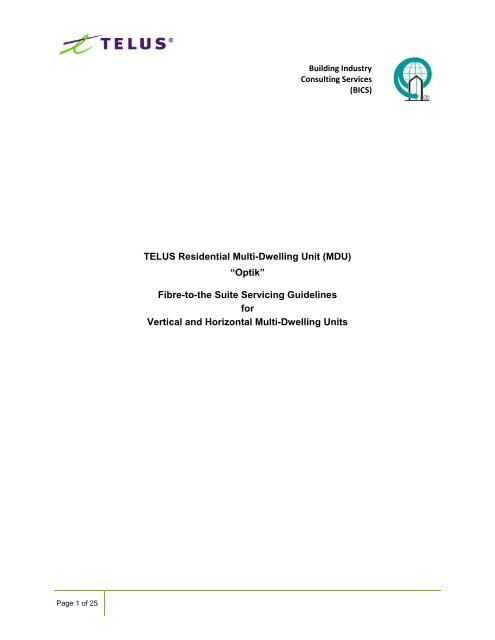
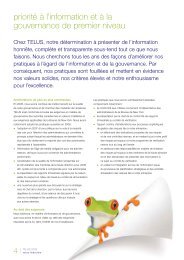
![DISK004:[98CLG6.98CLG3726]BA3726A.;28 - About TELUS](https://img.yumpu.com/16786670/1/190x245/disk00498clg698clg3726ba3726a28-about-telus.jpg?quality=85)
